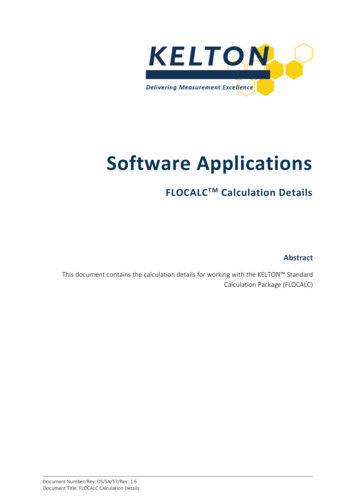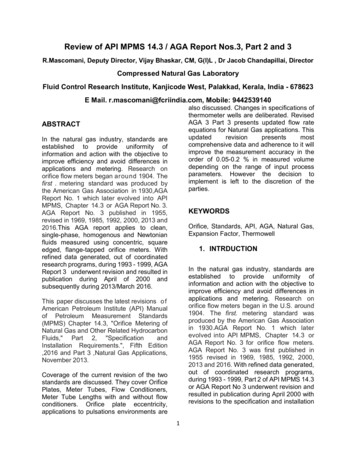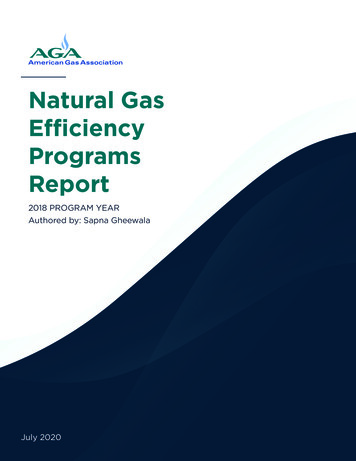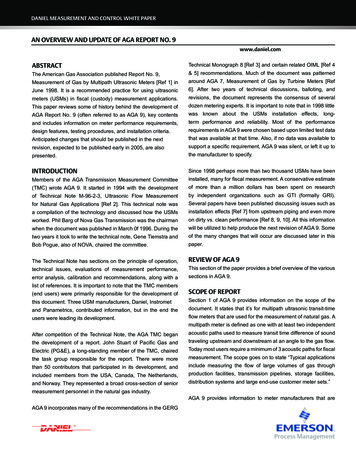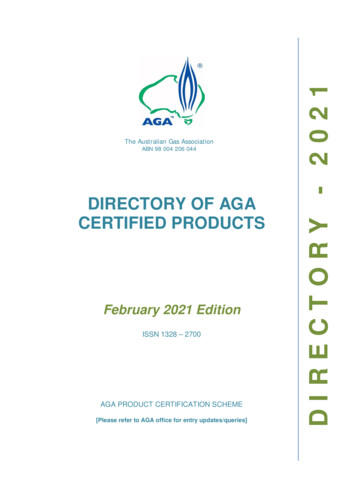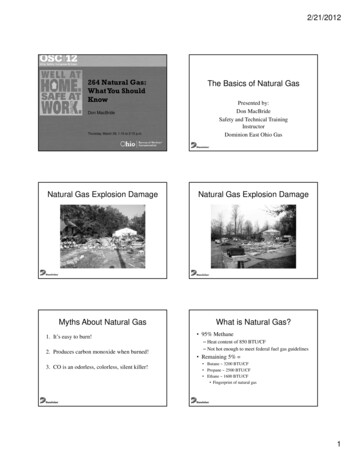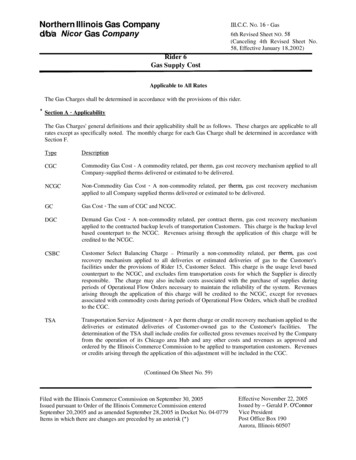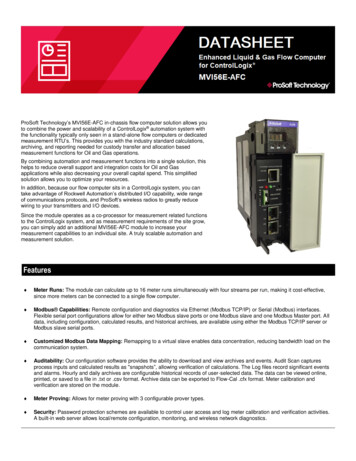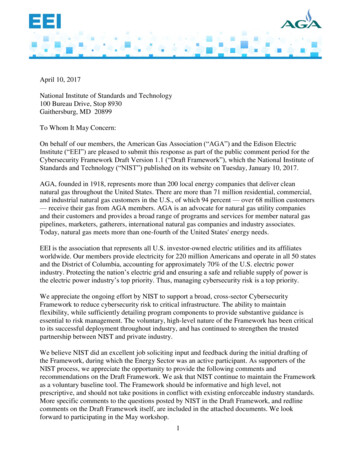
Transcription
April 10, 2017National Institute of Standards and Technology100 Bureau Drive, Stop 8930Gaithersburg, MD 20899To Whom It May Concern:On behalf of our members, the American Gas Association (“AGA”) and the Edison ElectricInstitute (“EEI”) are pleased to submit this response as part of the public comment period for theCybersecurity Framework Draft Version 1.1 (“Draft Framework”), which the National Institute ofStandards and Technology (“NIST”) published on its website on Tuesday, January 10, 2017.AGA, founded in 1918, represents more than 200 local energy companies that deliver cleannatural gas throughout the United States. There are more than 71 million residential, commercial,and industrial natural gas customers in the U.S., of which 94 percent — over 68 million customers— receive their gas from AGA members. AGA is an advocate for natural gas utility companiesand their customers and provides a broad range of programs and services for member natural gaspipelines, marketers, gatherers, international natural gas companies and industry associates.Today, natural gas meets more than one-fourth of the United States' energy needs.EEI is the association that represents all U.S. investor-owned electric utilities and its affiliatesworldwide. Our members provide electricity for 220 million Americans and operate in all 50 statesand the District of Columbia, accounting for approximately 70% of the U.S. electric powerindustry. Protecting the nation’s electric grid and ensuring a safe and reliable supply of power isthe electric power industry’s top priority. Thus, managing cybersecurity risk is a top priority.We appreciate the ongoing effort by NIST to support a broad, cross-sector CybersecurityFramework to reduce cybersecurity risk to critical infrastructure. The ability to maintainflexibility, while sufficiently detailing program components to provide substantive guidance isessential to risk management. The voluntary, high-level nature of the Framework has been criticalto its successful deployment throughout industry, and has continued to strengthen the trustedpartnership between NIST and private industry.We believe NIST did an excellent job soliciting input and feedback during the initial drafting ofthe Framework, during which the Energy Sector was an active participant. As supporters of theNIST process, we appreciate the opportunity to provide the following comments andrecommendations on the Draft Framework. We ask that NIST continue to maintain the Frameworkas a voluntary baseline tool. The Framework should be informative and high level, notprescriptive, and should not take positions in conflict with existing enforceable industry standards.More specific comments to the questions posted by NIST in the Draft Framework, and redlinecomments on the Draft Framework itself, are included in the attached documents. We lookforward to participating in the May workshop.1
The Framework should remain a voluntary baseline tool that identifies existing, cross-sectorcritical infrastructure cybersecurity standards and guidanceCybersecurity capabilities vary by sector and entity. As noted during the initial drafting of theFramework, reducing the nation’s cyber risk requires bringing the cybersecurity of criticalinfrastructure from all 16 sectors up to a minimum baseline level. This level will not be achievedin the same way for each sector, nor will it be achieved homogenously by organizations withineach sector as they all have different critical infrastructure risk profiles. Anything further shouldcontinue to be addressed at the sector level through additional guidance in coordination withSector-Specific Agencies (“SSA”).Strong member use and promotion of the FrameworkAfter the NIST Cybersecurity Framework was released, AGA and EEI members worked with theirSSA, the Department of Energy, to align existing cybersecurity risk management programs andtools with the Framework, ultimately producing the Energy Sector Cybersecurity FrameworkImplementation Guidance (“Implementation Guidance”). AGA and EEI members adapted variouscontrol-based approaches such as NIST’s Security and Privacy Controls for Federal InformationSystems and Organizations (NIST SP 800-53), others used DOE’s Cybersecurity CapabilityMaturity Model (“C2M2”), and some have integrated these and other approaches. The Frameworkand its alignment with C2M2 is helpful in encouraging further and more in-depth use of the C2M2and other cybersecurity approaches. The Implementation Guidance will be updated to incorporatethe new additions to the Framework, once finalized.AGA, EEI, and our members continue to support NIST’s efforts by raising awareness of theFramework through a variety of means, including outreach to our member committees andconferences focused on cybersecurity, through the Electricity Subsector Coordinating Council(“ESCC”) and the Oil and Natural Gas Subsector Coordinating Council (“ONG SCC”), and incross-sector venues. Though our members have already employed various cybersecurity riskmanagement activities, the Framework has helped to encourage more comprehensive and mature,enterprise-wide approaches to cybersecurity.Cybersecurity risk management is a top priority of our membersIn addition to the Framework, our members continue to use a number of sector specific standards,guidelines, and practices. Examples include the mandatory and enforceable North AmericanElectric Reliability Corporation Critical Infrastructure Protection (“NERC CIP”) CybersecurityStandards, DOE’s voluntary Electricity and Oil and Natural Gas Subsector CybersecurityCapabilities and Maturity Models, the voluntary Control Systems Cyber Security Guidelines forthe Natural Gas Pipeline Industry, the Transportation Security Administration (“TSA”) PipelineSecurity Guidelines, and the voluntary NIST Guidelines for Smart Grid Cyber Security (NISTIR7628). These existing requirements and guidelines provide comprehensive guidance that helpelectricity asset owners and operators to assess, develop, and improve their cybersecuritycapabilities. Electric power industry representatives also helped DOE, NIST, and NERC todevelop the Electricity Subsector Cybersecurity Risk Management Process to help tailorcybersecurity risk management processes to meet organizational requirements. This guidelinehelps utilities incorporate cybersecurity risk considerations into their existing corporate riskmanagement processes.2
Minimize duplication of efforts, and avoid conflicting with existing rules and standardsIn July 2016, the Federal Energy Regulatory Commission (“FERC”) issued an order directing theNERC to “develop a forward‐looking, objective‐driven Reliability Standard that provides securitycontrols for supply chain management for industrial control system hardware, software, andservices associated with bulk electric system operations.” 1 The NERC CIP standard, CIP-013-1 –Cyber Security – Supply Chain Risk Management (“NERC CIP-013-1”), is currently in draft form.Publishing an updated Framework prior to the release of this mandatory, enforceable standard willbe inherently problematic for combination gas-electric companies. NIST should avoid taking aposition in opposition to this standard, as it will discourage entities required to implement NERCCIP-013-1 from also implementing version 1.1 of the NIST Cybersecurity Framework. NISTshould work to harmonize the Framework updates with the approved version of NERC CIP-013-1to avoid a counterproductive duplication of efforts.Supply Chain Risk Management is an ongoing challengeWe view the addition of supply-chain risk management as a substantial improvement to theoriginal Cybersecurity Framework, provided that it aligns with the aforementioned NERC CIP013-1. We ask, however, that NIST review the updated text and appendices for relevance tooperational technology (OT) in addition to information technology (IT), which appears to be thecurrent focus of the draft language. Industry already has taken a number of steps to work withsuppliers on viewing cybersecurity as a feature of their products. EEI established a cross-functionteam of information technology, cybersecurity, sourcing, risk management, and legal professionalsto focus on this challenge as well as cyber supply chain integrity risk. Similarly, AGA has set up atask group to address this risk. Both AGA and EEI members are involved in DOE’s supply EnergySector Critical Manufacturers Working Group (ESCMWG), which works to bring togetherutilities and the vendor community to address supply chain risks.The updated Framework should continue to be informative and voluntary guidelines, but notprescriptiveDetermining what is prescriptive may be difficult due to the volume of input received by NISTfrom various stakeholders who have different experience, expertise, and perspective. Afoundational characteristic of the Framework is that it remains a voluntary guide and is not anauditable standard. Drafters should be careful not to introduce prescriptive and directive languageinto the Framework, which creates risk for companies and may lead to reduced implementation ofthe updated Framework. Some of the newly proposed language, particularly in Section 4.2, “Typesof Cybersecurity Measurement” is too prescriptive and points to specific technologies, creatingapplicability problems across the 16 sectors. Given the rapid evolution of tools and capabilities,the Framework and subcategories should continue to be outcome/objective focused to remaintechnology neutral. Avoiding specific technical solutions enables asset owner and operators toselect the practices to reduce risk as well as the appropriate security controls and technologies tobe used.1Revised Critical Infrastructure Protection Reliability Standards, Order No. 829 156 FERC ¶ 61,050 at P 4 (July 21,2016).3
Framework methodology should be tailored to improving critical infrastructure cybersecuritywhile protecting individual privacy and civil libertiesSection 7(c) of Presidential Executive Order 13636 specifies that “[t]he Cybersecurity Frameworkshall include methodologies to identify and mitigate impacts of the Cybersecurity Framework andassociated information security measures or controls on business confidentiality, and to protectindividual privacy and individual liberties.”2 Protecting customer privacy and civil liberties isimportant, and issues regarding those matters raised during the initial drafting of the Frameworkremain. However, we are concerned that instead of focusing on means to limit the privacy impactsof the Framework, the methodology appears to recommend independent privacy protectionsunrelated to the protection of critical infrastructure. Similar to risk management, the scope ofprivacy and civil liberty protections are beyond that of cybersecurity. The purpose of theframework is to “help owners and operators of critical infrastructure identify, assess, and managecyber risk.”3 The methodology provided should be tailored to the purpose of the Framework: toimprove critical infrastructure cybersecurity. Additionally, it is critical that the privacymethodology is clear and actionable. The existing language does not readily allow companies todiscern how to use the methodology or determine whether current practices already incorporate itselements.Consider who is providing input to the Draft Framework processFinally, we recommend that NIST consider who is providing the input when updating theFramework and determining how to use the input. We recognize and support NIST’s efforts toencourage feedback from critical infrastructure owners and operators and cybersecurity staff,specifically those who have operational, managerial and policy experience and responsibilities forcybersecurity, technology and/or standards development for critical infrastructure companies.We greatly appreciate the NIST efforts to update the Framework, as well as to listen to andincorporate our feedback. AGA, EEI, and our members look forward to continued collaborationwith NIST and our other government partners to improve the cybersecurity of criticalinfrastructure.Sincerely,Scott I. AaronsonJim LinnExecutive Director, Security & Business Continuity Managing Director, Information TechnologyEdison Electric InstituteAmerican Gas Association23The President, Executive Order 13636—Improving Critical Infrastructure Cybersecurity, February 19,2013, 3-03915.pdf.Executive Order 13636, Improving Critical Infrastructure Cybersecurity Sec. 7(b).4
With the release of the Cybersecurity Framework Draft Version 1.1, NIST requested answers tothe following questions:Are there any topics not addressed in the draft Framework Version 1.1 that could beaddressed in the final? No additional topics should be addressed in Version 1.1. However, the discussion ofmetrics in the new section “4.0 Measuring and Demonstrating Cybersecurity” could beexpanded with the addition of additional practical guidance.How do the changes made in the draft Version 1.1 impact the cybersecurity ecosystem? There is a greater emphasis on supply chain, though unfortunately the focus is largely oncompliance-oriented controls. These types of controls may have some value but they oftenare not preventive. Reference to industry-standard certifications should be considered. Foroperational technology, there should be a greater recognition of the role of vendorinvolvement in system design and configuration. For those using Version 1.0, would the proposed changes impact your current use of theFramework? If so, how? We do not see substantial impact. The added language would provide additional supportfor third-party security review programs, however, NIST should recognize that under thecurrent way SCRM has been incorporated in the Draft Framework, companies may not beable to identify as “Adaptive” if its suppliers are not SCRM compliant.For those not currently using Version 1.0, does the draft Version 1.1 affect your decision touse the Framework? If so, how? Many of our members currently use the Framework. We anticipate that following thepublication of version 1.1, the changes to the Framework will be reviewed for use by ourmembers.Does this proposed update adequately reflect advances made in the Roadmap areas? No opinion.Is there a better label than “version 1.1” for this update? No opinion.Based on this update, activities in Roadmap areas, and activities in the cybersecurityecosystem, are there additional areas that should be added to the Roadmap? Are there anyareas that should be removed from the Roadmap? Comments: The next revision of the Framework should focus on challenges associated withoperational technology (as compared to IT) and the emerging Internet of Things (IoT).5
Framework for ImprovingCritical Infrastructure CybersecurityDraft Version 1.1National Institute of Standards and TechnologyJanuary 10, 2017
January 10, 2017Cybersecurity FrameworkDraft Version 1.1Not e t o R e v i e w e r s o n t h e Upd a t e a n d Nex t S t e p sThe draft Version 1.1 of Cybersecurity Framework refines, clarifies, and enhances thepredecessor version 1.0.Version 1.1 can be implemented by first time and current Framework users. Current users canimplement Version 1.1 with minimal or no disruption, as refinements were made with theobjective of being compatible with Version 1.0.As with Version 1.0, use of the Version 1.1 is voluntary. Users of Version 1.1 are invited tocustomize the Framework to maximize organizational value.The impetus to change and the proposed changes were collected from:Feedback and frequently asked questions to NIST since release of Framework Version1.0 in February 2014,105 responses to the December 2015 request for information (RFI), Views onthe Framework for Improving Critical Infrastructure Cybersecurity, andComments provided by approximately 800 attendees at a workshop held inGaithersburg, Maryland on April 6-7, 2016.In addition, NIST previously released Version 1.0 of the Cybersecurity Framework with acompanion document, NIST Roadmap for Improving Critical Infrastructure Cybersecurity. ThisRoadmap highlighted key “areas of improvement” for further “development, alignment, andcollaboration.” Through both private and public sector efforts, some areas of improvement haveadvanced enough to be included in the Framework Version 1.1.Key refinements, clarifications, and enhancements in Framework Version 1.1 include:UpdateA new section oncybersecurity measurementGreatly expandedexplanation of usingFramework for CyberSupply Chain RiskManagement purposesRefinements to betteraccount for authentication,authorization, and identityproofingBetter explanation of therelationship betweenImplementation Tiers andProfilesDescription of UpdateAdded Section 4.0 Measuring and Demonstrating Cybersecurity to discusscorrelation of business results to cybersecurity risk management metrics andmeasures.Considerations of Cyber Supply Chain Risk Management (SCRM) have beenadded throughout the document. An expanded Section 3.3 CommunicatingCybersecurity Requirements with Stakeholders has been added to help usersbetter understand Cyber SCRM. Cyber SCRM has also been added as aproperty of Implementation Tiers. Finally, a Supply Chain Risk ManagementCategory has been added to the Framework Core.The language of the Access Control Category has been refined to account forauthentication, authorization, and identity proofing. A Subcategory has beenadded to that Category. Finally, the Category has been renamed to IdentityManagement and Access Control (PR.AC) to better represent the scope of theCategory and corresponding Subcategories.Added language to Section 3.2 Establishing or Improving a CybersecurityProgram on using Framework Tiers in Framework implementation. Addedlanguage to Framework Tiers to reflect integration of Frameworkconsiderations within organizational risk management programs. UpdatedFigure 2.0 to include actions from the Framework Tiers.iiComment [KB2]: Should this say “to help”or “helps” (or even “has been added tohelp”)? It seems grammatically incorrect ascurrently written.Comment [KB1]: As added these are lessrecommendation. The wording may prohibitsome companies from attaining their desiredtier, due to suppliers inability to comply.
January 10, 2017Cybersecurity FrameworkDraft Version 1.1A more detailed review of Version 1.1 refinements, clarifications, and enhancements can befound in Appendix D.NIST is seeking public comment on this draft Framework Version 1.1, specifically regarding thefollowing questions:Are there any topics not addressed in the draft Framework Version 1.1 that couldbe addressed in the final?How do the changes made in the draft Version 1.1 impact the cybersecurity ecosystem?For those using Version 1.0, would the proposed changes impact your current use ofthe Framework? If so, how?For those not currently using Version 1.0, does the draft Version 1.1 affect your decisionto use the Framework? If so, how?Does this proposed update adequately reflect advances made in the Roadmap areas?Is there a better label than “version 1.1” for this update?Based on this update, activities in Roadmap areas, and activities in the cybersecurityecosystem, are there additional areas that should be added to the Roadmap? Are thereany areas that should be removed from the Roadmap?Feedback and comments should be directed to cyberframework@nist.gov. After reviewingpublic comments regarding the draft Version 1.1 and convening a workshop on the Framework,NIST intends to publish a final Framework Version 1.1 around the fall of 2017.iii
January 10, 2017Cybersecurity FrameworkDraft Version 1.1Table of ContentsExecutive Summary . 11.0Framework Introduction . 32.0Framework Basics . 73.0How to Use the Framework . 144.0Measuring and Demonstrating Cybersecurity . 21Appendix A: Framework Core . 25Appendix B: Glossary . 47Appendix C: Acronyms . 50Appendix D: Errata . 51List of FiguresFigure 1: Framework Core Structure .7Figure 2: Notional Information and Decision Flows within an Organization . 13Figure 3: Cyber Supply Chain Relationship . 17List of TablesTable 1: Types of Framework Measurement . 23Table 2: Function and Category Unique Identifiers .26Table 3: Framework Core. 27Table 4: Changes in Framework Version 1.1. 51iv
January 10, 2017Cybersecurity FrameworkDraft Version 1.1Executive SummaryThe national and economic security of the United States depends on the reliable functioning ofcritical infrastructure. Cybersecurity threats exploit the increased complexity and connectivity ofcritical infrastructure systems, placing the Nation’s security, economy, and public safety andhealth at risk. Similar to financial and reputational risk, cybersecurity risk affects a company’sbottom line. It can drive up costs and impact revenue. It can harm an organization’s ability toinnovate and to gain and maintain customers.To better address these risks, the President issued Executive Order 13636, “Improving CriticalInfrastructure Cybersecurity,” on February 12, 2013, which established that “[i]t is the Policy ofthe United States to enhance the security and resilience of the Nation’s critical infrastructure andto maintain a cyber environment that encourages efficiency, innovation, and economic prosperitywhile promoting safety, security, business confidentiality, privacy, and civil liberties.” Inenacting this policy, the Executive Order calls for the development of a voluntary risk-basedCybersecurity Framework – a set of industry standards and best practices to help organizationsmanage cybersecurity risks. The resulting Framework, created through collaboration betweengovernment and the private sector, uses a common language to address and manage cybersecurityrisk in a cost-effective way based on business needs without placing additional regulatoryrequirements on businesses. There are many ways to achieve security and organizations should not belimited in their approach. This Framework recognizes that there are existing standards and regulations, as well asother voluntary frameworks for critical infrastructure sectors to use for cybersecurity risk management.The Framework focuses on using business drivers to guide cybersecurity activities andconsidering cybersecurity risks as part of the organization’s risk management processes. TheFramework consists of three parts: the Framework Core, the Framework Profile, and theFramework Implementation Tiers. The Framework Core is a set of cybersecurity activities,outcomes, and informative references that are common across critical infrastructure sectors,providing the detailed guidance for developing individual organizational Profiles. Through use ofthe Profiles, the Framework will help the organization align its cybersecurity activities with itsbusiness requirements, risk tolerances, and resources. The Tiers provide a mechanism fororganizations to view and understand the characteristics of their approach to managingcybersecurity risk.The Executive Order also requires that the Framework include a methodology to protectindividual privacy and civil liberties when critical infrastructure organizations conductcybersecurity activities. While processes and existing needs will differ, the Framework can assistorganizations in incorporating privacy and civil liberties as part of a comprehensive cybersecurityprogram.The Framework enables organizations – regardless of size, degree of cybersecurity risk, orcybersecurity sophistication – to apply the principles and best practices of risk management toimproving the security and resilience of critical infrastructure. The Framework providesorganization and structure to today’s multiple approaches to cybersecurity by assemblingstandards, guidelines, and practices that are working effectively in industry today. Moreover,because it references globally recognized standards for cybersecurity, the Framework can also beused by organizations located outside the United States and can serve as a model for internationalcooperation on strengthening critical infrastructure cybersecurity.1
January 10, 2017Cybersecurity FrameworkDraft Version 1.1The Framework is not a one-size-fits-all approach to managing cybersecurity risk for criticalinfrastructure. This Framework recognizes that innovation by cyber adversaries is dynamic,and defending against them requires organizations to react constantly. As a static document,the Framework cannot be expected to provide full protection from those adversaries.Organizations will continue to have unique risks – different threats, different vulnerabilities,different risk tolerances – and how they implement the practices in the Framework will vary.Organizations can determine activities that are important to critical service delivery and canprioritize investments to maximize the impact of each dollar spent. Ultimately, the Framework isaimed at reducing and better managing cybersecurity risks.The Framework is a living document and will continue to be updated and improved as industryprovides feedback on implementation. NIST will continue coordinating with industry as directedin the Cybersecurity Enhancement Act of 20141. As the Framework is put into practice, lessonslearned will be integrated into future versions. This will ensure it is meeting the needs of criticalinfrastructure owners and operators in a dynamic and challenging environment of new threats,risks, and solutions.Use, evolution, and sharing of best practices of this voluntary Framework are the next steps toimprove the cybersecurity of our Nation’s critical infrastructure – providing guidance forindividual organizations, while increasing the cybersecurity posture of the Nation’s criticalinfrastructure as a whole.1See 15 U.S.C. § 272(e)(1)(A)(i). The Cybersecurity Enhancement Act of 2014 (S.1353) became public law 113-274on December 18, 2014 and may be found at: e-bill/1353/text.2Formatted: Character scale: 105%Comment [KB3]: Coordinating with industryDeleted: isComment [KB4]: What defines the term"best practices"? Is this based from otherindustries, an aggregation of a given industrycollectively, or based on federalrecommendations of securing ourinfrastructures?
January 10, 20171.0Cybersecurity FrameworkDraft Version 1.1Framework IntroductionThe national and economic security of the United States depends on the reliable functioning ofcritical infrastructure. To strengthen the resilience of this infrastructure, President Obama issuedExecutive Order 13636 (EO), “Improving Critical Infrastructure Cybersecurity,” on February 12,2013.2 This Executive Order calls for the development of a voluntary Cybersecurity Framework(“Framework”) that provides a “prioritized, flexible, repeatable, performance-based, and costeffective approach” to manage cybersecurity risk for those processes, information, and systemsdirectly involved in the delivery of critical infrastructure services. The Framework, developed incollaboration with industry, provides guidance to an organization on managing cybersecurityrisk.Critical infrastructure is defined in the EO as “systems and assets, whether physical or virtual, sovital to the United States that the incapacity or destruction of such systems and assets would havea debilitating impact on security, national economic security, national public health or safety, orany combination of those matters.” Due to the increasing pressures from external and internalthreats, organizations responsible for critical infrastructure need to have a consistent and iterativeapproach to identifying, assessing, and managing cybersecurity risk. This approach is necessaryregardless of an organization’s size, threat exposure, or cybersecurity sophistication today.The critical infrastructure community includes public and private owners and operators, andother entities with a role in securing the Nation’s infrastructure. Members of each criticalinfrastructure sector perform functions that are supported by information technology (IT) andindustrial control systems (ICS).3 This reliance on technology, communication, and theinterconnectivity of IT and ICS has changed and expanded the potential vulnerabilities andincreased potential risk to operations. For example, as ICS and the data produced in ICSoperations are increasingly used to deliver critical services and support business decisions, thepotential impacts of a cybersecurity incident on an organization’s business, assets, health andsafety of individuals, and the environment should be considered. To
to focus on this challenge as well as cyber supply chain integrity risk. Similarly, AGA has set up a task group to address this risk. Both AGA and EEI members are involved in DOE's supply Energy Sector Critical Manufacturers Working Group (ESCMWG), which works to bring together utilities and the vendor community to address supply chain risks.

